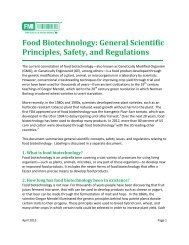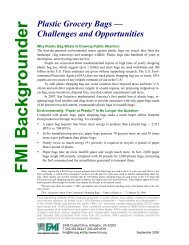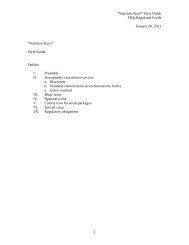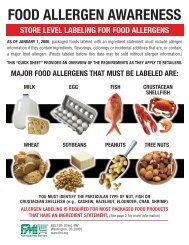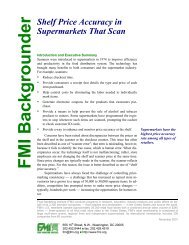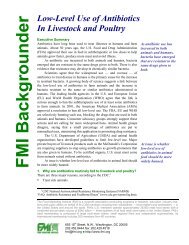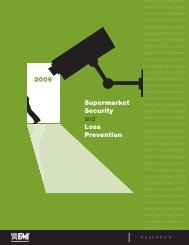Consumer Shopping Habits for Wellness and Environmentally ...
Consumer Shopping Habits for Wellness and Environmentally ...
Consumer Shopping Habits for Wellness and Environmentally ...
You also want an ePaper? Increase the reach of your titles
YUMPU automatically turns print PDFs into web optimized ePapers that Google loves.
H+W Relevance describes if <strong>and</strong> how a particular category of goods relates to H+W, from a<br />
consumer st<strong>and</strong>point. This in<strong>for</strong>mation is useful <strong>for</strong><br />
Building overall product <strong>and</strong> retail mix strategies<br />
Prioritizing the most relevant categories <strong>for</strong> development (in connection with H+W programs<br />
or promotions)<br />
Purchase Criteria lays out the key decision points <strong>for</strong> the product category, by consumer H+W<br />
orientation. This provides<br />
Guidance on product attributes to prioritize <strong>for</strong> new product development<br />
Attributes to call out on product packaging <strong>and</strong> in retail promotions<br />
For most categories, these decision criteria are placed on charts.<br />
Br<strong>and</strong> <strong>and</strong> Product Offerings describes how completely a product category covers consumer<br />
preferences across a H+W continuum. This illuminates opportunities to fill consumer need gaps,<br />
whether absolute (i.e. the products don‘t exist) or relative (the products are out there, but consumers<br />
are not finding them in stores they frequent). We comment on both the product/category <strong>and</strong> retail<br />
level where relevant, however, much of the retail discussion is reserved <strong>for</strong> the next chapter.<br />
For the most relevant H+W categories, we provide charts of example products showing the range of<br />
appeal to consumers from Periphery to Core. It is worth noting, however, that the examples are<br />
provided to help illustrate how consumers‘ values are encoded into their purchases <strong>and</strong> as<br />
comparative references <strong>for</strong> use in product <strong>and</strong> retail planning. As such, the charts are not intended to<br />
be comprehensive.<br />
Intentional Omission of Price in Quantitative Category Data<br />
Please note that in the below categories, where we asked quantitatively about purchase decision<br />
factors or criteria, we intentionally omitted price as a factor. This is due to our extensive experience<br />
asking such questions, which in<strong>for</strong>ms us that price will almost invariably rise to the top of any set of<br />
factors in such questions. We omitted price so as to allow other, potentially more category-specific<br />
factors, to have clear visibility. For example, when we ask an industry-st<strong>and</strong>ard ―top two box‖<br />
question, price is always one of the top two. In leaving price out <strong>and</strong> simply assuming it as a factor,<br />
we increase the number of non-price factors that rise to the surface, making <strong>for</strong> more nuanced<br />
survey results.<br />
Gateway Categories<br />
A ―gateway‖ category is capable of facilitating an evolutionary shift in a consumer‘s purchase<br />
behavior. As stated above, some categories serve as H+W ―gateways‖ <strong>and</strong> some do not. For now,<br />
primary focus should be on the following existing key gateway categories that have direct H+W ties.<br />
Functional Beverages<br />
65




